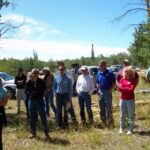In Wyoming’s Red Desert, the checkerboard has fueled a wild horse stalemate
By Mike Koshmrl
A dozen or so wild horse advocates and photographers were gathered on a ridgeline near White Mountain in August 2024 when news started spreading that federal land managers got the OK from the courts to eliminate two entire herds, and a part of another, from 2.1 million acres of the area known as the Red Desert. Cheyenne resident and amateur photographer Robyn Smith was immediately bummed. “Argh, oh crap,” she said. “That’s a lot of horses.” More than 3,000 horses, US District Court of Wyoming Judge Kelly Rankin had ruled, could go.
The group of activists were gathered to oversee an unrelated horse roundup in the so-called checkerboard region of southwest Wyoming, a 40-mile-wide swath of land where one-square-mile blocks of private and Bureau of Land Management (BLM) property meet at the corners. Fences are few in the region, so thousands of horses pass on and off the private land daily. These walkabouts, and the underlying land ownership pattern, have proven a land management quagmire that has been the source of a half century of conflict, despite sporadic coordination.
Rankin’s ruling in favor of horse removal was just the latest development in the debate over whether and how many mustangs should be allowed to roam the checkerboard. The back and forth involves woolgrowers and cattle ranchers who don’t want the free-roaming horses on their private land, the BLM, an agency that’s required by the Wild Free-Roaming Horses and Burros Act to maintain them on the federal property, and wild horse advocates, who want to protect the animals and health of the herds.
Some 14 months later, however, the herds slated for elimination were still there. They’d even grown larger. The reason is litigation, which has dominated the 54 years since horses in the Red Desert became federally protected. As herd sizes continuously exceed goals, frustrations have grown. But middle-ground solutions have failed to gain traction as the camps in the checkerboard horse dispute have become gridlocked, leaving today’s land managers and horses at an impasse.
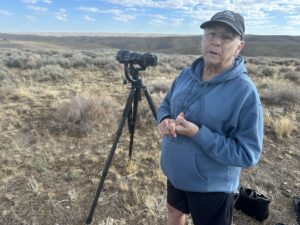
Before 1971, when the Wild and Free-Roaming Horses and Burros Act passed, ranchers in the checkerboard who run cattle and sheep as a collective under the Rock Springs Grazing Association took wild horse management into their own hands. “They removed excess numbers, and at that time they went to slaughter, for the most part,” says Christi Chapman, who’s a longtime wild horse advocate: She co-founded the all-volunteer Wyoming Wild Horse Improvement Partnership. “They did a good job, because they cared about the land and they wanted to have enough room for their livestock. But they liked the horses—they didn’t want to see them go completely away.”
After the Wild Horse Act passed, management shifted to federal officials. The law protects free-roaming horses from “capture, branding, harassment, or death,” prohibits commercial sale for slaughter, and declares them “living symbols of the historic and pioneer spirit of the West.” It passed both chambers of Congress unanimously and was shepherded by the matriarch of wild horse advocacy, Velma Johnston, who was known as Wild Horse Annie.
At that time, wild horses and burros roamed free on roughly 54 million acres of federal land, mostly BLM property. The new federal law didn’t demand blanket protections for equines everywhere. Land managers inventoried the West, looking at factors like vegetation and water, and ultimately defined 179 “herd management areas” covering nearly 32 million acres in 10 states where the landscape was considered able to sustainably support horses. In another 20-million-plus inhabited acres, free-roaming horses weren’t thought of as practical long-term residents because of habitat constraints or resource scarcity—these were labeled “herd areas” and are not managed for horses. In southwest Wyoming’s Red Desert and Green River Basin, nine HMAs were established, some of which included hundreds of square miles of the checkerboard.
A key provision of the Wild Horses and Burros Act instructs agencies to “remove stray wild horses from private lands as soon as practicable” when asked by a landowner, who are prohibited from removing or destroying horses on their own. That made the broad swath of interchanging public and private land that forms the checkerboard tricky, and negotiations essential. Shortly after it passed, members of the Rock Springs Grazing Association met with Johnston and the BLM to discuss management for horse herds in the region. In the new era, the association had plenty of incentive to work with the BLM to keep horse numbers in check. Their livestock depended on the same rangeland and would have to compete for forage with the free-roaming horses, which can reach 1,000 pounds and face little predation. “They had a great conversation,” Chapman says. They even came to terms on population targets.
But the horses thrived and the herds grew in the absence of rancher management—unchecked, herds can swell by 20 percent annually. The association’s ranchers tried to get the BLM to step in with large roundups to no avail, and by the late 1970s they sued. A negotiated legal settlement came out of it, and that deal was for four herds totaling no more than 1,600 animals in the Red Desert region. “BLM-Wyoming complied without delay, but it took from 1980 to 1985 to reduce the number of horses from almost 7,000 to 1,600,” Rock Springs Grazing Association Manager Don Schramm testified to Wyoming lawmakers in 2023. The herds had sprawled across the landscape and gathering them was difficult and costly—as was finding a home for them, because the free-roaming animals could no longer be killed.
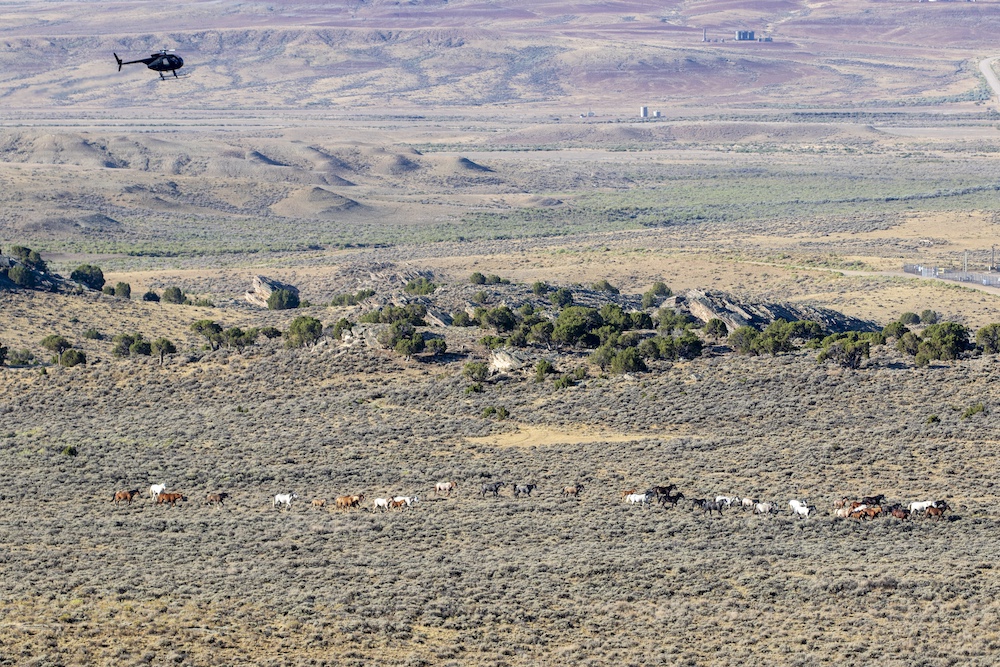
Horse populations fluctuated in the two decades that followed. Roundups would drive numbers down to near the 1,600-animal target, but then years would go by. “They would double by the time of the next roundup,” Schramm said in his testimony. “We did our best. We had the support of the state, BLM, wild horse interest groups, the Washington office employees, administrative officers and RSGA. It was a team effort.” But it wasn’t enough, and the wild horses spent far more time above the agreed-upon population limits than near or below the threshold.
“I will say this: I feel like it’s not the BLM’s fault,” Chapman says. She pinpointed two reasons, naming constant litigation and a lack of resources for federal land managers to carry out their horse-removal duties. Wild horse management has proven to be an extraordinary drain on BLM coffers. Roundups, which rely on helicopters and big teams of wranglers, are pricey, but most of the expense goes toward paying for the horses to live out their days. Some rounded-up mustangs are adopted and domesticated, but most end up in long-term corrals and in off-range pastures where board, feed, and veterinary bills cost more than $100 million annually.
Finally, in 2010, frustrated ranchers revoked their consent to tolerate horses on private land in the checkerboard, asking that the herds be removed entirely. The BLM went along, citing the act, and even sought to remove herds from the public land squares interspersed throughout the checkerboard. This would have been an almost unprecedented move. While roundups eliminating horses from the “herd areas” are somewhat routine, the designated herds have remarkable staying power.
“BLM has only zeroed out a herd two times in history,” says Bill Eubanks, an attorney who has represented horse advocacy plaintiffs in the Red Desert dispute for over a decade. The Colorado and Nevada herds that were eliminated faced dire straits from a landscape that lacked enough resources for their survival. Animals were “emaciated,” Eubanks says, and federal law explicitly permits removing herds “in order to preserve and maintain a thriving natural ecological balance” in areas. “The agency ultimately documented that they could not keep a genetically viable, self-sustaining wild horse herd,” Eubanks says, “because it was just impossible.”
The rationale for getting rid of the Red Desert herds was starkly different. It hinged on the RSGA asserting its rights to have stray wild horses removed from private lands as soon as possible, and the assumption that herd elimination was the only reasonable way to do that in the checkerboard.
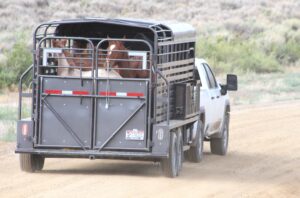
The association sued BLM again three years later, and out of it came another settlement agreement. This one called for eliminating two herds and shrinking two others. Wild horse advocacy groups, represented by Eubanks, got involved with their own lawsuit, arguing violations of the Wild Horse Act, National Environmental Policy Act and other federal laws. After a federal district court defeat, the horse advocates prevailed when the 10th Circuit Court of Appeals ruled in 2016 that the federal agency broke the law by treating the entire checkerboard as if it were private property.
Appellate Judge Monroe McKay and the court acknowledged the “practical realities of the checkerboard” and the need for BLM to find a “workable solution,” but still faulted the agency for ignoring a key provision of the act. “It seems to me that the only way the BLM can ultimately lawfully achieve its [ecological balance] duty to maintain wild herds and prevent destruction of viability caused by over grazing on public lands is to go back to step one and make appropriate judgments by redetermining the HMAs without the non-permissive use of private lands,” McKay wrote.
While the BLM went back to the drawing board, the herds kept steadily growing. In the winter of 2022–2023, the federal agency commissioned an infrared aerial survey that found roughly 4,700 horses in the Red Desert herds. Roundups followed and a similar assessment at the end of 2024 found just shy of 3,700 animals.
Around the West, the pace of roundups has long been inadequate to keep up with population growth, in some areas resulting in ecological harm rather than ecological balance. As of spring 2025, the number of free-roaming horses and burros nationwide was approaching 75,000—nearly triple the BLM’s targeted numbers. Nevada, which hosts nearly half of them, has been the poster child of feral horse overpopulation run amok, and its state biologists have reported that the equines eat more forage than all the native ungulate species, like elk and mule deer, combined.
Impacts to wildlife have also been documented in Wyoming. A University of Wyoming-led research team examined how free-roaming horses influence sage grouse and found evidence that overpopulated Red Desert herds are hurting the imperiled birds’ survival rates by breaking up sagebrush, increasing bare ground and denuding watering holes. Wildlife managers on the Wind River Indian Reservation—which isn’t subject to the Wild Free-Roaming Horses and Burros Act—reported dramatic, almost overnight changes after rounding up nearly 8,000 horses in 2022 and 2023. “It was at an ecological crisis point,” US Fish and Wildlife Service Supervisory Biologist Pat Hnilicka said at the time. “If something wasn’t done, there was no turning back.”
In the Red Desert, near where her family ranches, Chapman has seen feral horses eat themselves out of a home during periods of drought and succumb to severe winters. It was especially hard to watch, she says, during the winter of 2022–2023. “We found families of horses dead within feet of each other,” Chapman says. “It was just really sad.”
Wild horse enthusiasts, however, contend that equines are being unfairly scapegoated when it comes to impacts on the land. Casper College instructor Chad Hanson, who’s an avid horse photographer and writer, says that their impacts on grasslands are “red herrings”—arguments intended to distract from more significant concerns. “The BLM’s rangeland assessments make it clear: Livestock represent the most significant threat to the health and vitality of our public lands,” says Hanson, who joined the checkerboard horse lawsuit as a plaintiff.
But there is a distinction between how horse and livestock impacts to rangeland are handled, according to Jim Magagna, a longtime lobbyist for the Wyoming Stock Growers Association. “It’s the only major species of animals out there that isn’t managed,” he says of Red Desert horses. “We manage our livestock—we harvest our calves and lambs every fall. We manage our wildlife through hunting seasons.” Because wild horses, legally, are neither livestock nor wildlife, the BLM’s toolkit for managing them is much more constrained.
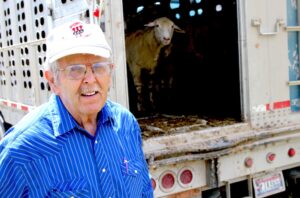
Attempting to remedy the court’s concerns after the 2016 loss, federal authorities prepared an environmental impact statement and updated its resource management plans for the Rock Springs and Rawlins areas. “We’ve been trying to come up with a solution,” says Brad Purdy, a senior advisor for the BLM’s Wyoming office. The federal agency’s analysis assessed different scenarios, in part demonstrating “adequate forage, water, cover and space” to support horses if the trimmed-down herds were confined to solid-block public land outside the checkerboard. Still, there were concerns the herds would easily drift back onto private land.
Ideas for solutions included fencing the checkerboard and keeping horses on public ground, but that would require extensive fencing that would bisect big game migration routes and could even harm sage grouse prone to striking them. It was called “not technically feasible” and the gargantuan task was dismissed.
The assessment also considered and dismissed a land swap to consolidate private and public property. “For a land exchange, you’ve got to have a willing partner—and I don’t think we had a willing partner,” says Purdy, the BLM-Wyoming senior advisor. “I’m not saying that in a negative way. It’s completely up to private landowners whether they want to engage in a land exchange with the Bureau of Land Management.”
The option the agency ultimately landed on was to get rid of the Great Divide Basin and Salt Wells Creek herds, which dwell in areas that are respectively 48 percent and 72 percent checkerboard. The northwestern portion of the Adobe Town Herd, an area that’s 42 percent checkerboard, would also be lopped off and managed for zero horses. In total, the contested plans called for ridding roughly 2.1 million acres—an area about the size of Yellowstone National Park—of more than 3,000 free-roaming horses. “When you weighed it all out, this was the most informed and the best decision, I think, the BLM could have made,” Purdy says.
Initially, the courts were on board, upholding the agency’s plans. Rankin’s August 2024 opinion—the ruling that bummed out Smith and the other roundup observers—recognized the BLM’s bind of having to remove the private land horses and having no practical means of keeping others on checkerboarded public land. Repped by Eubanks, horse advocacy groups and individuals again appealed to the 10th Circuit Court of Appeals.
By spring 2025, BLM was already setting in motion its renewed plans, but history repeated itself, and again the 10th Circuit put a stop to the roundups. Like nearly a decade prior, the court faulted BLM for not demonstrating how removing all horses from public land in the checkerboard is necessary to achieve a “thriving natural ecological balance”—language from the Wild Free-Roaming Horses and Burros Act. “They said it’s the guiding principle of the act, as Congress wrote it, and you can’t just ignore that,” Eubanks says.
Federal officials turned heads by announcing they were proceeding with the elimination roundups despite the appeals court ruling, sparking another lawsuit, then another—and eventually an assurance that nothing would happen before summer 2026.
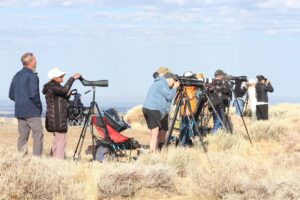
So several thousand Red Desert horses remain on the landscape, and land managers, stockgrowers and horse advocates are at a stalemate. “This whole controversy, it’s been a standoff for 15 years,” Chapman says. “I’ve been here since day one, right in the middle of it.” The 10th Circuit’s summer 2025 opinion instructed BLM to go back to federal district court to resolve concerns about “ecological balance,” but BLM’s earlier plans stated there was no ecological justification for removing the Red Desert herds. There was no scarcity of forage, water, cover and space, according to its own analysis.
Pro-horse plaintiffs say the stakes are high. Herds around the West could be at risk if BLM prevails in removing whole herds because of the checkerboard’s private land, Eubanks says. Every herd management area in the country contains private inholdings or non-federal land. “Where do you draw the line?” the attorney says. “There’s not really any coherent reason why it could not apply elsewhere. Does BLM see this [argument] as specific to these herds, or is this really something that they’re testing out? We don’t know.”
Meanwhile, ranchers’ patience has been exhausted after decades of legal disputes and the BLM failing to achieve targeted numbers. Magagna, at the Wyoming Stock Growers Association, sees few prospects for coexisting with free-roaming horses in the long-term. “At this point, the only way that the landowners could be satisfied outside of a total removal would be if they were reduced down to [agreed-upon] numbers, with a firm guarantee that the horses would be held at those numbers,” he says.
Others say the potential solution was prematurely dismissed by the BLM. “I think the right solution is for the federal government to have land swaps with the checkerboard landowners and consolidate the private lands and the public lands,” says Erik Molvar, a biologist who directs the Western Watershed Project, an environmental group that focuses on negative impacts of livestock grazing. “Once you consolidate the private lands, then under the Wild Horse and Burro Act, the wild horses that stray can be removed back onto the public lands—and the private landowners can have wild-horse-free private lands.”
As long as a decade ago, Eubanks was encouraging BLM to consider a land swap as a mutually palatable solution so that the Rock Springs Grazing Association would be unencumbered by horses, which would then dwell only on solid-block public lands. “Not one time has BLM even explored the idea—they just refuse to even consider whether it’s a viable option,” Eubanks says. “What’s especially peculiar is BLM does land exchanges of substantial size. They’re the agency that specializes in these federal/non-federal land swaps for precisely this type of purpose.”
For now, the steady stream of litigation is keeping the Red Desert horse dispute in flux. As this story was going to press, the federal agency and Rock Springs Grazing Association had not shown their hand, declining interviews about legal next steps to satisfy the court’s concerns about “ecological balance.”
“They could interpret the 10th Circuit opinion differently than I do,” says Eubanks. “We have very little intel on how they’re going to approach these issues. It may be that the outcome of their evaluation sparks more litigation. I’m sure that would be a surprise to no one.”
This story was created in partnership with WyoFile, an independent nonprofit news organization that covers Wyoming.
Mike Koshmrl is a Lander-based journalist who reports on wildlife and natural resource issues for WyoFile.
Header image: Research in Wyoming has indicated that wild horses may threaten sage grouse survival rates by breaking up sagebrush, increasing bare ground, and denuding watering holes. Wild horse enthusiasts counter that horses are being unfairly scapegoated for environmental degradation, laying the blame on livestock instead. (Allegra Keenoo and Jacqueline Alderman/Bureau of Land Management)

